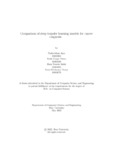| dc.contributor.advisor | Uddin, Jia | |
| dc.contributor.advisor | Ashraf, Faisal Bin | |
| dc.contributor.author | Joya, Nadia Islam | |
| dc.contributor.author | Turna, Tasfia Haque | |
| dc.contributor.author | Sukhi, Zinia Nawrin | |
| dc.contributor.author | Promy, Tania Ferdousey | |
| dc.date.accessioned | 2023-05-09T05:23:54Z | |
| dc.date.available | 2023-05-09T05:23:54Z | |
| dc.date.copyright | 2022 | |
| dc.date.issued | 2022-05 | |
| dc.identifier.other | ID 18101105 | |
| dc.identifier.other | ID 18301280 | |
| dc.identifier.other | ID 18301193 | |
| dc.identifier.other | ID 18101678 | |
| dc.identifier.uri | http://hdl.handle.net/10361/18250 | |
| dc.description | This thesis is submitted in partial fulfillment of the requirements for the degree of Bachelor of Science in Computer Science, 2022. | en_US |
| dc.description | Cataloged from PDF version of thesis. | |
| dc.description | Includes bibliographical references (pages 51-56). | |
| dc.description.abstract | Cancer is known to be one of the most lethal diseases among all the diseases in
the world. It is clinically known as ’Malignant Neoplasm which is a vast group
of diseases that encompasses unmonitored cell expansion. It can begin anywhere
in the body such as the breast, skin, liver, lungs, brain, and so on. According to
GLOBOCAN 2020, approximately 19.3 million new cases were found and around
10.0 million deaths have occurred for cancer globally. As reported by the National
Institutes of Health (NIH), the projected growth of new cancer cases is forecast at
29.5 million and cancer-related deaths at 16.4 million through 2040. Breast, colorectal,
endometrial, lung, oral, skin, and ovarian cancers are some of the most common
malignancies that people develop. There are many medical procedures to identify
the cancer cell such as mammography, MRI, CT scan which are common methods
for cancer diagnosis. The methods used above have been found to be ineffective and
necessitate the development of new and smarter cancer diagnostic technologies. Persuaded
by the phenomena of deep learning in medical image classification tasks, the
recommended initiative targets to analyze the performance of deep transfer learning
for cancer cell classification. Transfer learning is used in visual categorization to
solve cross-domain learning issues by transferring useful data from the source domain
to the task domain. Cancer, also known as tumor, must be discovered early
and accurately in order to determine what treatment alternatives are available. Even
if each modality has its own set of problems, such as a convoluted medical history,
incorrect diagnosis, and therapy, all of which are major causes of death. Artificial
Intelligence-based medical diagnosis is a novel strategy in medicine that eliminates
the need for pathologists to work with material in favor of pixels to diagnose illness
(imaging in medical sector). Therefore, in our paper, we want to offer a narrative of
four different deep transfer learning techniques Vgg16, InceptionV3, MobilenetV2
and Resnet50 to examine the accuracy, compare and discuss for the detection of
breast, lung, and melanoma (skin) cancer. | en_US |
| dc.description.statementofresponsibility | Nadia Islam Joya | |
| dc.description.statementofresponsibility | Tasfia Haque Turna | |
| dc.description.statementofresponsibility | Zinia Nawrin Sukhi | |
| dc.description.statementofresponsibility | Tania Ferdousey Promy | |
| dc.format.extent | 56 pages | |
| dc.language.iso | en | en_US |
| dc.publisher | Brac University | en_US |
| dc.rights | Brac University theses are protected by copyright. They may be viewed from this source for any purpose, but reproduction or distribution in any format is prohibited without written permission. | |
| dc.subject | Convolutional Neural Network(CNN) | en_US |
| dc.subject | Deep transfer learning | en_US |
| dc.subject | Cancer detection | en_US |
| dc.subject | Image processing | en_US |
| dc.subject.lcsh | Neural networks (Computer science) | |
| dc.subject.lcsh | Image processing--Digital techniques. | |
| dc.title | Comparison of deep transfer learning models for cancer diagnosis | en_US |
| dc.type | Thesis | en_US |
| dc.contributor.department | Department of Computer Science and Engineering, Brac University | |
| dc.description.degree | B. Computer Science | |

